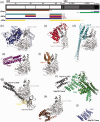Cytosolic protein quality control machinery: Interactions of Hsp70 with a network of co-chaperones and substrates
- PMID: 33730888
- PMCID: PMC8243209
- DOI: 10.1177/1535370221999812
Cytosolic protein quality control machinery: Interactions of Hsp70 with a network of co-chaperones and substrates
Abstract
The chaperone heat shock protein 70 (Hsp70) and its network of co-chaperones serve as a central hub of cellular protein quality control mechanisms. Domain organization in Hsp70 dictates ATPase activity, ATP dependent allosteric regulation, client/substrate binding and release, and interactions with co-chaperones. The protein quality control activities of Hsp70 are classified as foldase, holdase, and disaggregase activities. Co-chaperones directly assisting protein refolding included J domain proteins and nucleotide exchange factors. However, co-chaperones can also be grouped and explored based on which domain of Hsp70 they interact. Here we discuss how the network of cytosolic co-chaperones for Hsp70 contributes to the functions of Hsp70 while closely looking at their structural features. Comparison of domain organization and the structures of co-chaperones enables greater understanding of the interactions, mechanisms of action, and roles played in protein quality control.
Keywords: BAG; CHIP; GrpE; Hip; Hop; Hsp110; Hsp40; Hsp70; Hsp90; J domain protein; SMADs; co-chaperones; molecular chaperones; nucleotide exchange factor; protein quality control.
Conflict of interest statement
Figures


Similar articles
-
Nucleotide Exchange Factors for Hsp70 Molecular Chaperones: GrpE, Hsp110/Grp170, HspBP1/Sil1, and BAG Domain Proteins.Subcell Biochem. 2023;101:1-39. doi: 10.1007/978-3-031-14740-1_1. Subcell Biochem. 2023. PMID: 36520302 Review.
-
GrpE, Hsp110/Grp170, HspBP1/Sil1 and BAG domain proteins: nucleotide exchange factors for Hsp70 molecular chaperones.Subcell Biochem. 2015;78:1-33. doi: 10.1007/978-3-319-11731-7_1. Subcell Biochem. 2015. PMID: 25487014 Review.
-
Molecular chaperones of the Hsp110 family act as nucleotide exchange factors of Hsp70s.EMBO J. 2006 Jun 7;25(11):2519-28. doi: 10.1038/sj.emboj.7601138. Epub 2006 May 11. EMBO J. 2006. PMID: 16688212 Free PMC article.
-
CHIP: A Co-chaperone for Degradation by the Proteasome and Lysosome.Subcell Biochem. 2023;101:351-387. doi: 10.1007/978-3-031-14740-1_12. Subcell Biochem. 2023. PMID: 36520313
-
The human cytosolic molecular chaperones hsp90, hsp70 (hsc70) and hdj-1 have distinct roles in recognition of a non-native protein and protein refolding.EMBO J. 1996 Jun 17;15(12):2969-79. EMBO J. 1996. PMID: 8670798 Free PMC article.
Cited by
-
Role of Heat Shock Proteins (HSP70 and HSP90) in Viral Infection.Int J Mol Sci. 2021 Aug 29;22(17):9366. doi: 10.3390/ijms22179366. Int J Mol Sci. 2021. PMID: 34502274 Free PMC article. Review.
-
Understanding Insulin in the Age of Precision Medicine and Big Data: Under-Explored Nature of Genomics.Biomolecules. 2023 Jan 30;13(2):257. doi: 10.3390/biom13020257. Biomolecules. 2023. PMID: 36830626 Free PMC article. Review.
-
A novel and unique ATP hydrolysis to AMP by a human Hsp70 Binding immunoglobin protein (BiP).Protein Sci. 2022 Apr;31(4):797-810. doi: 10.1002/pro.4267. Epub 2021 Dec 31. Protein Sci. 2022. PMID: 34941000 Free PMC article.
-
In Silico Analysis of SARS-CoV-2 Non-Structural Proteins Reveals an Interaction with the Host's Heat Shock Proteins That May Contribute to Viral Replications and Development.Curr Issues Mol Biol. 2023 Dec 18;45(12):10225-10247. doi: 10.3390/cimb45120638. Curr Issues Mol Biol. 2023. PMID: 38132484 Free PMC article.
-
Chaperone-dependent and chaperone-independent functions of carboxylate clamp tetratricopeptide repeat (CC-TPR) proteins.Trends Biochem Sci. 2025 Feb;50(2):121-133. doi: 10.1016/j.tibs.2024.11.004. Epub 2024 Dec 19. Trends Biochem Sci. 2025. PMID: 39706778 Review.
References
-
- Morán Luengo T, Mayer MP, Rüdiger SGD. The Hsp70–Hsp90 chaperone Cascade in protein folding. Trends Cell Biol 2019; 29:164–77 - PubMed
-
- Gething M-J. Molecular chaperones: individualists or groupies? Curr Opin Cell Biol 1991; 3:610–4 - PubMed
-
- Craig EA, Gross CA. Is hsp70 the cellular thermometer. Trends Biochem Sci 1991; 16:135–40 - PubMed
Publication types
MeSH terms
Substances
Grants and funding
LinkOut - more resources
Full Text Sources
Other Literature Sources
Miscellaneous

